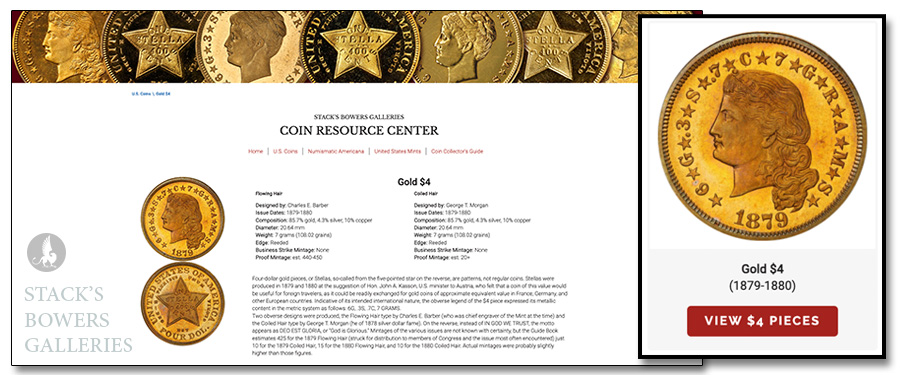
The Coin Resource Center is, as noted in earlier blogs, a work in process. It launched with entries on two complete series (Morgan dollars and Walking Liberty half dollars) and numerous entries on notable U.S. rarities. The U.S. rarities category includes $4 Stellas, among the rarest and most distinctive gold coins produced by the U.S. Mint. Though generally defined as patterns, Stellas are often included in advanced U.S. gold type sets. Some numismatic mythmaking has always surrounded this series, but recent scholarship details a fascinating story.
$4 Stellas are the product of a series of late 19th century coinage experiments and proposals for goloid coinage in combination with specific diplomatic exigencies. Developed by Dr. William Hubbell, a Philadelphia patent attorney and inventor, goloid is an alloy of gold, silver, and copper that Hubbell, along with politicians and well-connected people, thought could usher in an era of metric coinage. A number of pattern coins from the period were produced to test the alloy’s feasibility for various denominations. The $4 Stella is arguably the best-known of these experiments.
The specific proposal that resulted in the $4 Stella originated with John Kasson, a Congressman and diplomat who in 1879 was serving as U.S. Ambassador to Austria. (Philatelists may know Kasson as the first Postmaster General.) In January of that year, he submitted a report to the Committee on Coinage, Weights, and Measures (on which he had served as chairman in the 1860s) explaining that the Austrian eight-florin gold coin was the unit of account for the U.S. embassy and advocating for the introduction of a comparable gold coin to replace the $3 gold piece then still in production. Kasson and other advocates for such coinages though that it might ease the embassy’s accounting difficulties and possibly facilitate international transactions. The eight-florin coin was worth about $3.88. Kasson had before recommended the replacement of the $3 gold piece with a coin of the same weight as the Austrian eight-florin.
Pursuant to Kasson’s suggestions, Alexander Stephens (chairman of the Committee on Coinage, Weights, and Measures and former vice president of the Confederate States of America) and Dr. Hubbell (who was trying to have his patented “goloid,” adopted for U.S. coinage) petitioned the Treasury to have patterns produced. Chief Engraver Charles Barber prepared designs for the patterns, which were produced from December 1879 to May 1880.
$4 Stellas stand on their own in the CRC as an individual denomination and within that broader listing are three main varieties: the 1879 Flowing and Coiled Hair and the 1880 Coiled Hair. Like other CRC listings, the entries for $4 Stellas include links to recent auction appearances and to Coins in Motion videos.
The 1879 Flowing Hair is the most common of the three, with a mintage of 425. Many were distributed to members of Congress and among surviving examples are a number characterized as ex-jewelry, inspiring a popular myth that the coins were given as favors to sex workers by elected officials. Documentary evidence of this practice is, at present, nonexistent. Between 10 and 20 of the other varieties are reported. The circumstances of their production are opaque.
Given their history and rarity, $4 Stellas command substantial prices at auction. Six-figure bids are the norm, putting them out of reach for modestly-capitalized collectors. Roger Burdette’s article on $4 Stellas in his 2020 collection Fakes, Fads, and Foibles is highly recommended.





